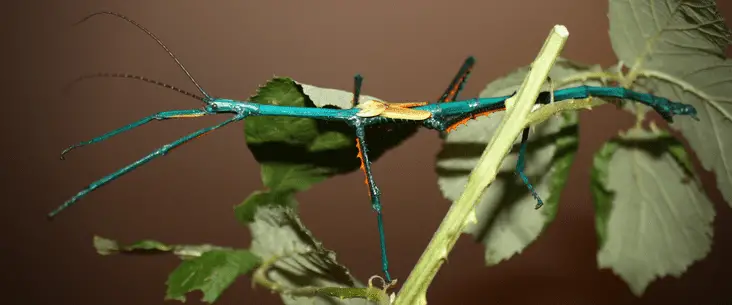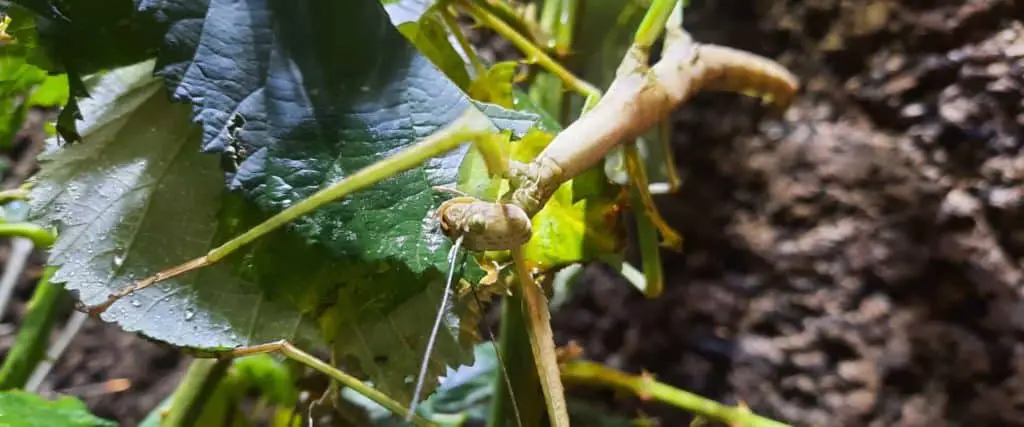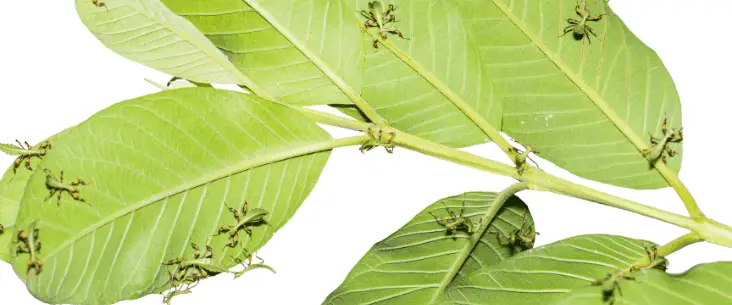If you say stick insects or walking stick, you immediately think of a cylindrical insect crawling on long legs. The most popular one is the Indian stick insect. This iconic insect is one of the most popular exotic pets to keep. This beginner-friendly insect is also very suitable for kids to keep as their first pet. They are also perfect as a school buddy in the classroom. But even these easy-to-care pet deserves the best care and has to be properly looked after. In this practical care guide, we discuss in detail the care they need and how you best can keep Indian stick insects as pets, but in a nutshell:
These easy to keep Indian stick insects need an enclosure of at least 20x20x30cm, a temperature around 20°C and a mildly humid environment to stay healthy. You can feed Indian stick insects with a combination of leaves from privet, bramble or ivy.
Now, even when they are labelled as one of the easiest stick insects you can keep, they still need proper care. To ensure their welfare we discuss all their needs in this practical care guide.
We partner with companies that offer products that we think are great for you to use, and that can help you achieve your goals. If you purchase through our partner links, we get paid for the referral at no additional cost to you! Please read our disclaimer for more info.
About the Indian stick insect
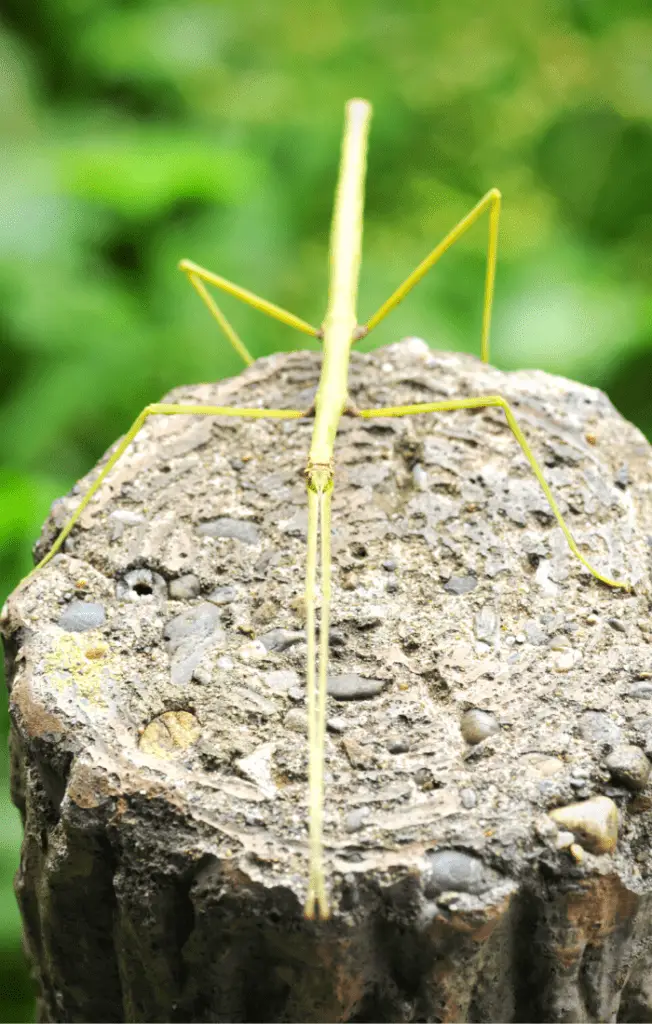
Appearance and camouflage
Indian stick insects have a cylindrical body shape existing out of three parts: Head, thorax and abdomen. They have normally an olive green colour, although there are specimens that are more brown or yellow-green. They have 6 long legs that have the same colour as their body. Adults are around 8 to 10cm (3″-4″) long.
These colours and body shape make them very well camouflaged between the foliage. They can hardly be distinguished between the twigs and leaves they are sitting on. When resting you generally see that they use their front legs to extend the shape of their body so they even look more like a twig.
Behaviour, temperament and handling
These stick insects are very docile. They are nocturnal and are most active during nighttime. During daylight, they sit quietly on a branch. When they feel danger approaching they sometimes will rock from left to right mimicking a twig waving in the wind. They are perfect when you want to start keeping stick insects and are also a perfect pet for kids.
Like any other stick insect, they are very delicate and you should handle them with great care. Don’t grab them on their body, but let them walk onto your hand instead. You can use a small artist’s paintbrush to guide them towards your hand. When you keep them on your hand, don’t raise them too high above the ground, because they can (let them) fall off your hand and damage themselves. Kids can handle them as well, but I recommend guidance from an adult at all times.
Related read: 15 Surprisingly Interesting Facts About Stick Insects
Care summary
Tank setup for Indian stick insects
Although Indian stick insects don’t have high needs, they still require proper housing to keep them happy and healthy. So let us first look at how to set up the perfect tank for your stick insects.
Tank type and size
Stick insects can be housed in different types of enclosures. Normally a reptile tank fulfils all their needs. But you can also use an aquarium or plastic storage box. Keep in mind that they live in a moist environment, so enclosures of wood or carton box is not recommended (or at least not for permanent housing, it can be used for temporary housing while cleaning the tank).
Reptile terrariums are often the most expensive tanks and a plastic storage box is in this case much cheaper. There are also so-called critter boxes that can work as well.
An important feature of the tank is that it has enough ventilation and fresh air to keep your stick insects healthy. Without proper ventilation it will accumulate moisture and moult will quickly grow inside. Also, the air becomes musty and can make your stick insects sick. With plastic storage boxes, you’ll need to cut holes in the lid and cover them with a fine metal screen mesh. This is available in most hardware stores or available on Amazon.
Proper access to the enclosure is highly recommended to easily clean and refresh the food plants. So your tank should have a top lid door or front door so you can do all the care needed.
As for the size, we use the general of keeping them in a tank that is at least three times the adult body length in height and two times the adult body length in width. For one or two Indian stick insects an enclosure with a size of 20x20x30 cm (8″x8″x12″) is sufficient. However, larger groups of stick insects are better to house in a bigger tank. For 5-10 stick insects I recommend an enclosure of 30x30x45 cm (12″x12″x18″). Stick insects need more height to allow successful moulting. They will hang onto a branch or the top lid and slowly crawl out of their old skin (beautiful to observe).
Tank substrate and decor
Indian stick insects don’t particularly need any substrate in their enclosure. You can add a substrate for decoration purposes or to stimulate higher humidity in the enclosure. In that case, you could use some white playground sand or even better coconut fibre. Both are easy to buy on Amazon and I can recommend you to buy the Eco Earth Coconut Fibre.
However, choosing a substrate makes cleaning more difficult and you have to refresh the substrate from time to time. Some keepers prefer to use a layer of kitchen towel to make it easier to clean and still have proper humidity in the enclosure. More on that later on in the cleaning section.
Stick insects need to be able to climb up the enclosure. A few dead twigs in the enclosure would be perfect for this. You can also add some cork background from Amazon so they can climb up or use it for resting. It also makes your tank more appealing to look at. When you use natural materials out of the backyard, please clean them thoroughly with water (without soap!!) or place them for 48 hours in the freezer to kill all fungi and other creatures that can damage your stick insects.
Tank location
Now we have discussed what kind of tank you can use and how to set it up, it is also important to mention where you place the tank. Always place the tank inside. These animals are not suitable to be kept outside (for at least most regions). Keep them in a location that has a stable climate, especially for the temperature. High fluctuations in temperature are bad for stick insects.
Avoid placing the tank in direct sunlight. The sun will quickly heat up the enclosure to temperatures that are deadly for stick insects. I also highly recommend not placing the enclosure near audio equipment like televisions and/or sound boxes. And also be aware of the access of other pets like dogs and cats. Not that they quickly eat a stick insect, but more that they can knock over the enclosure.
When keeping these animals in a classroom, place the tank in a corner that is most quiet and away from (heavy) vibrations. So, for example, don’t place the tank at the door of the classroom where all kids run in and out.
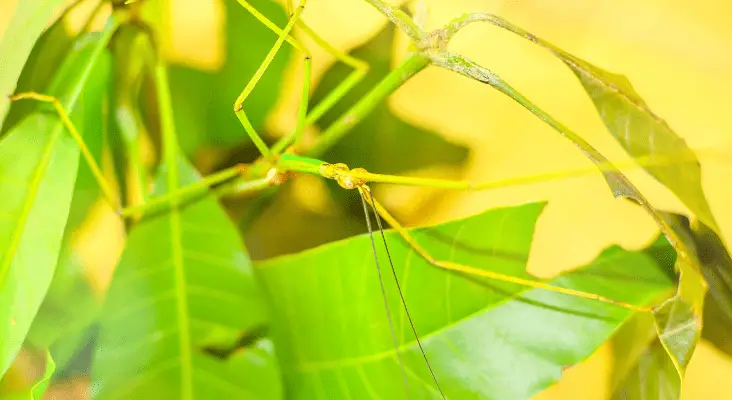
Shopping list for Indian stick insects
Here I selected a couple of items that I recommend using for keeping stick insects. I have selected different tanks (and one netting cage) depending on what you prefer. However, throughout the article, I link to other products that I recommend and personally use as well.
Environmental conditions for Indian stick insects
Now that we have discussed how to house and set up the tank for your stick insects, we will focus from now on how to care for them. We start off with the environmental conditions you need to maintain for keeping stick insects. Stick insects are dependent on their environment and can’t maintain their own body heat. So first let’s look at the temperature.
Temperature and heating
Indian stick insects can best be kept at a temperature between 16°C and 24°C (60°F-75°F). The optimum lies around a stable 20°C (68°F). Generally, room temperature is therefore sufficient as long as the room temperature is steady.
When you live in a colder region you should use some sort of heating to maintain the optimum temperature. You could use a heat lamp or a heating pad for this. Always place the heating source outside the enclosure. You could also use a better heating system for the room so the whole room is at a good temperature.
A heating lamp can also be used for a regular light cycle. More on that later. As mentioned before, don’t place the tank in direct sunlight. Although it heats up the enclosure, it will quickly become too warm for the stick insects which eventually results in dead animals.
Humidity and spraying
Stick insects like a mild humid environment. Indian stick insect originates from the tropics of India and generally, our houses are too dry. A humidity of around 60%-75% would be perfect. You can increase the humidity by mist spraying the enclosure two or three times a week. Don’t overdo the spraying, just mildly spray the inside of the enclosure.
Besides the increase of humidity, spraying water will provide water droplets that stick insects drink. They don’t drink water from a bowl. Although they can get the moisture out of their food, some spraying will provide valuable drinking water for them. Besides, it is really fun to watch how they will walk to a droplet and see it shrink.
Lightcycle
Although stick insects are nocturnal, they can appreciate a regular light cycle. A 12 hour day and 12 hour night work perfectly for them. You could use your heating lamp for that matter, but in absence of a heating lamp, you could use a normal LED light (that doesn’t heat up the enclosure).
Normal daylight can also be used as long as the tank is not placed directly in front of a window. However, indirect sunlight or light through a semi-transparent curtain works fine.
Food & feeding practice for Indian stick insects
Stick insects are herbivores and only eat certain leaves. Every stick insect has its own preferences when it comes to food plants.
Indian stick insects are probably one of the easiest to feed of all stick insects (maybe that’s why they are so popular?). Normally, stick insects are quite picky when it comes to food, however Indian stick insects eat a wide range of food plants.
You can feed Indian stick insects different plant matter such as:
- Bramble
- Oak
- Hazel
- Hawthorn
- Rose
- Privet
- Ivy
Privet and bramble are preferred by this species, however young stick insects can be fed ivy very well. The benefit is that bramble and privet stay green all year round. However, you can change food items sometimes depending on the availability. You can collect the leaves on stems in your backyard or in your neighbourhood park.
Be sure when you collect feeding material it is not treated with any pesticides or chemicals. Avoid collecting food material nearby agricultural fields, busy roads and parking. Car exhaust dust is also bad for stick insects.
Related read: What To Feed Stick Insects: A Helpful Guide
Collect the leaves on a little stem which you can place inside the enclosure. It is good practice to spray it first with some water and then place the stem in a little vase or plastic bottle half filled with water. This way the leaves stay fresh the longest. Refresh the food at least weekly, or when completely eaten or withered. These animals benefit to have food all the time.
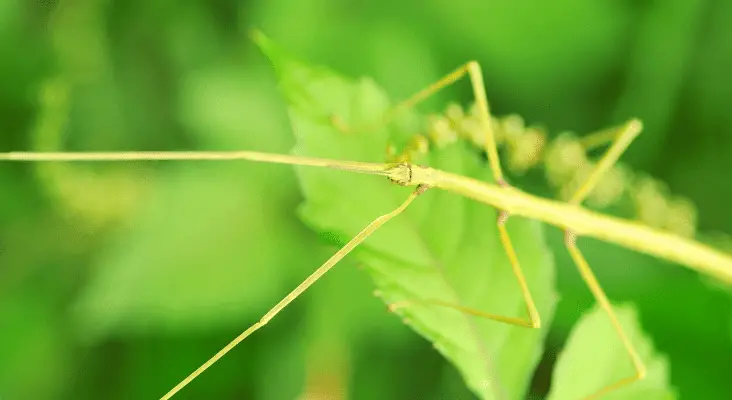
Cleaning routine
Cleaning — there is not much to it. Stick insects don’t make much mess (compared to some other common pets). You should daily check for dead animals and remove them. When food is low or withered you should refresh it with new plant material. At that moment you could clean the enclosure.
Cleaning the enclosure is not much more than removing all poop, old plant matter, and other dirt spots and collecting the eggs from the bottom floor. Eggs you say? Yes! Collect the eggs that lay on the floor. More on that later.
You can clean the glass walls with some water and citron or lime juice to remove (calcium) stains from spraying water.
And actually, that’s it. Easy right? Well, you could clean the entire enclosure once or twice a year. Remove all animals and place them in a temporary enclosure (plastic or carton box). Then rinse the whole enclosure with water without using any soap or disinfectant. When completely dried you can redecorate the enclosure (this is the time to place some new material in it) and place back your animals.
Breeding Indian stick insects
Indian stick insects are easy to breed. Before you know it you have many eggs and within 4-5 months the first baby stick insects will crawl around in your enclosure. Indian stick insects are parthenogenetic — meaning they will reproduce and lay eggs even without the presence of a male that will develop and hatch. These baby stick insects are clones of the female and will all be female too. So when you keep these stick insects as we discussed in this guide, you will have baby insects in no time.
Eggs are small, around 2mm in size. They look like small seeds of a plant (a part of their camouflage). The best is to collect them carefully and place them in a separate incubation tank. Best to use tweezers for this, but be careful not to press with any strength. Lay them on a bed of vermiculite or a layer of paper towel. This will help provide enough humidity for the development and hatching of the eggs.
However, before you know it you have more eggs or stick insects than you can care for. Only place a certain amount, say around 10 eggs, in the incubation tank. Because of the high hatching and survival rate, you will have quickly too many stick insects. The other eggs can be destroyed. The easiest way is to freeze them for a week before throwing them away in the trash. Never throw them away without destroying them or discard them in the garden. When they hatch in the wild they can destroy whole plants or gardens.
I’ve written a complete and detailed guide about breeding stick insects that I recommend you to read. And to provide even more information about stick insect eggs you may want to read the article about 17 things you should know about stick insect eggs.
Start with beginners-friendly Indian stick insects
I hope this guide helps you keep these wonderful creatures and to start your adventure in the world of stick insects. The Indian stick insect is a good one to start with, maybe even together with your kid. Learn more about the amazing world of stick insects. If you are interested, I’ve written a complete article about why I think stick insects are the best pet there is. Go check that one out as well.
For now, I can only wish you good luck with the care and enjoyment of these animals. If you have any additional questions you can use the contact form.
Much more to learn!
There is much more to learn about stick insects. For example, do stick insects need a substrate? You can find more articles about stick insects with plenty of practical tips to better understand and enjoy the keeping of stick insects as a pet.
Share this page!





